
To plot: The type of regression model suitable for the given data and explain as needed.
The exponential regression model is the best fir for the given data and is given as shown below
Given:
The given data is shown below
| X | Y |
| 1 | 11 |
| 8 | 6 |
| 15 | 4.8 |
| 16 | 4 |
| 17 | 2.5 |
Concept used:
The different types of regression models are shown below
Logarithmic regression model
Linear regression model
Exponential regression model
Where,
Plot:
The data x, y is entered in L1 and L2 and
| L1 (x) | L2 (y) | L3 (lnx) | L4 (lny) |
| 1 | 11 | 0.0000 | 2.3979 |
| 8 | 6 | 2.0794 | 1.7918 |
| 15 | 4.8 | 2.7081 | 1.5686 |
| 16 | 4 | 2.7726 | 1.3863 |
| 17 | 2.5 | 2.8332 | 0.9163 |
Using the data of
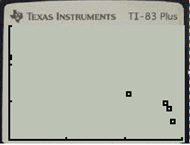
Using the data of
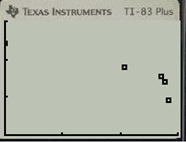
Using the data of x and
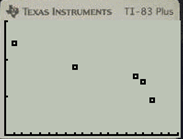
Interpretation:
With reference to scatterplots, the plot of x and
Calculation:
Press STAT button in the calculator and go to CALC menu to select Exp Reg option. Select the appropriate data from the lists and the following regression model output and its plot are observed.
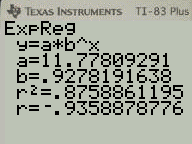
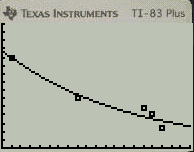
Conclusion:
The given data has a best fit exponential regression model with equation
Chapter 3 Solutions
Precalculus: Graphical, Numerical, Algebraic Common Core 10th Edition
- Instructions. "I have written solutions in text form, but I need experts to rewrite them in handwriting from A to Z, exactly as I have written, without any changes."arrow_forwardBoth in images okk. Instructions. "I have written solutions in text form, but I need experts to rewrite them in handwriting from A to Z, exactly as I have written, without any changes."arrow_forwardQuestion 1: If a barometer were built using oil (p = 0.92 g/cm³) instead of mercury (p = 13.6 g/cm³), would the column of oil be higher than, lower than, or the same as the column of mercury at 1.00 atm? If the level is different, by what factor? Explain. (5 pts) Solution: A barometer works based on the principle that the pressure exerted by the liquid column balances atmospheric pressure. The pressure is given by: P = pgh Since the atmospheric pressure remains constant (P = 1.00 atm), the height of the liquid column is inversely proportional to its density: Step 1: Given Data PHg hol=hgx Poil • Density of mercury: PHg = 13.6 g/cm³ Density of oil: Poil = 0.92 g/cm³ • Standard height of mercury at 1.00 atm: hμg Step 2: Compute Height of Oil = 760 mm = 0.760 m 13.6 hoil = 0.760 x 0.92 hoil = 0.760 × 14.78 hoil = 11.23 m Step 3: Compare Heights Since oil is less dense than mercury, the column of oil must be much taller than that of mercury. The factor by which it is taller is: Final…arrow_forward
- Question 3: A sealed flask at room temperature contains a mixture of neon (Ne) and nitrogen (N2) gases. Ne has a mass of 3.25 g and exerts a pressure of 48.2 torr. . N2 contributes a pressure of 142 torr. • What is the mass of the N2 in the flask? • Atomic mass of Ne = 20.1797 g/mol • Atomic mass of N = 14.0067 g/mol Solution: We will use the Ideal Gas Law to determine the number of moles of each gas and calculate the mass of N2. PV = nRT where: • P = total pressure • V volume of the flask (same for both gases) n = number of moles of gas • R 0.0821 L atm/mol K • T = Room temperature (assume 298 K) Since both gases are in the same flask, their partial pressures correspond to their mole fractions. Step 1: Convert Pressures to Atmospheres 48.2 PNe = 0.0634 atm 760 142 PN2 = = 0.1868 atm 760 Step 2: Determine Moles of Ne nNe = mass molar mass 3.25 nNe 20.1797 nne 0.1611 mol Step 3: Use Partial Pressure Ratio to Find narrow_forward"I have written solutions in text form, but I need experts to rewrite them in handwriting from A to Z, exactly as I have written, without any changes."arrow_forward3.12 (B). A horizontal beam AB is 4 m long and of constant flexural rigidity. It is rigidly built-in at the left-hand end A and simply supported on a non-yielding support at the right-hand end B. The beam carries Uniformly distributed vertical loading of 18 kN/m over its whole length, together with a vertical downward load of 10KN at 2.5 m from the end A. Sketch the S.F. and B.M. diagrams for the beam, indicating all main values. Cl. Struct. E.] CS.F. 45,10,376 KN, B.M. 186, +36.15 kNm.7arrow_forward
- Qize f(x) = x + 2x2 - 2 x² + 4x²² - Solve the equation using Newton Raphsonarrow_forward-b±√√b2-4ac 2a @4x²-12x+9=0 27 de febrero de 2025 -b±√√b2-4ac 2a ⑥2x²-4x-1=0 a = 4 b=-12 c=9 a = 2 b = 9 c = \ x=-42±√(2-4 (4) (9) 2(4)) X = (12) ±√44)-(360) 2(108) x = ±√ X = =±√√²-4(2) (1) 2() X = ±√ + X = X = + X₁ = = X₁ = X₁ = + X₁ = = =arrow_forward3.9 (A/B). A beam ABCDE, with A on the left, is 7 m long and is simply supported at Band E. The lengths of the various portions are AB 1-5m, BC = 1-5m, CD = 1 m and DE : 3 m. There is a uniformly distributed load of 15kN/m between B and a point 2m to the right of B and concentrated loads of 20 KN act at 4 and 0 with one of 50 KN at C. (a) Draw the S.F. diagrams and hence determine the position from A at which the S.F. is zero. (b) Determine the value of the B.M. at this point. (c) Sketch the B.M. diagram approximately to scale, quoting the principal values. [3.32 m, 69.8 KNm, 0, 30, 69.1, 68.1, 0 kNm.]arrow_forward
- 4. Verify that V X (aẢ) = (Va) XẢ + aV X Ả where Ả = xyz(x + y + 2) A and a = 3xy + 4zx by carrying out the detailed differentiations.arrow_forward3. For each of the arrow or quiver graphs shown below, determine analytically V°C and V X Č. From these analytical solutions, identify the extrema (+/-) and plot these points on the arrow graph. (a) C = −✰CosxSiny + ŷSinxCosy -π<ׂу<π Ty (b) C = −xSin2y + ŷCos2y x, y<π -π< (c) C = −xCosx + ŷSiny -π< x, y < πarrow_forward7.10 (B/C). A circular flat plate of diameter 305 mm and thickness 6.35 mm is clamped at the edges and subjected to a Uniform lateral pressure of 345 kN/m². Evaluate: (a) the central deflection, (b) the position and magnitude of the maximum radial stress. C6.1 x 10 m; 149.2 MN/m².] 100 200arrow_forward
 Calculus: Early TranscendentalsCalculusISBN:9781285741550Author:James StewartPublisher:Cengage Learning
Calculus: Early TranscendentalsCalculusISBN:9781285741550Author:James StewartPublisher:Cengage Learning Thomas' Calculus (14th Edition)CalculusISBN:9780134438986Author:Joel R. Hass, Christopher E. Heil, Maurice D. WeirPublisher:PEARSON
Thomas' Calculus (14th Edition)CalculusISBN:9780134438986Author:Joel R. Hass, Christopher E. Heil, Maurice D. WeirPublisher:PEARSON Calculus: Early Transcendentals (3rd Edition)CalculusISBN:9780134763644Author:William L. Briggs, Lyle Cochran, Bernard Gillett, Eric SchulzPublisher:PEARSON
Calculus: Early Transcendentals (3rd Edition)CalculusISBN:9780134763644Author:William L. Briggs, Lyle Cochran, Bernard Gillett, Eric SchulzPublisher:PEARSON Calculus: Early TranscendentalsCalculusISBN:9781319050740Author:Jon Rogawski, Colin Adams, Robert FranzosaPublisher:W. H. Freeman
Calculus: Early TranscendentalsCalculusISBN:9781319050740Author:Jon Rogawski, Colin Adams, Robert FranzosaPublisher:W. H. Freeman
 Calculus: Early Transcendental FunctionsCalculusISBN:9781337552516Author:Ron Larson, Bruce H. EdwardsPublisher:Cengage Learning
Calculus: Early Transcendental FunctionsCalculusISBN:9781337552516Author:Ron Larson, Bruce H. EdwardsPublisher:Cengage Learning





